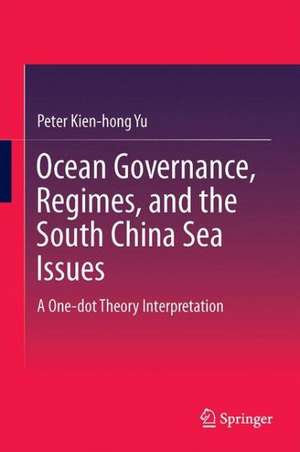Ocean Governance, Regimes, and the South China Sea Issues: A One-dot Theory Interpretation
Autor Peter Kien-Hong Yuen Limba Engleză Hardback – 19 mai 2015
| Toate formatele și edițiile | Preț | Express |
|---|---|---|
| Paperback (1) | 387.38 lei 6-8 săpt. | |
| Springer Nature Singapore – 23 oct 2016 | 387.38 lei 6-8 săpt. | |
| Hardback (1) | 394.87 lei 6-8 săpt. | |
| Springer Nature Singapore – 19 mai 2015 | 394.87 lei 6-8 săpt. |
Preț: 394.87 lei
Nou
Puncte Express: 592
Preț estimativ în valută:
75.57€ • 78.41$ • 63.16£
75.57€ • 78.41$ • 63.16£
Carte tipărită la comandă
Livrare economică 17-31 martie
Preluare comenzi: 021 569.72.76
Specificații
ISBN-13: 9789812873286
ISBN-10: 9812873287
Pagini: 170
Ilustrații: XIII, 269 p. 26 illus.
Dimensiuni: 155 x 235 x 22 mm
Greutate: 0.58 kg
Ediția:2015
Editura: Springer Nature Singapore
Colecția Springer
Locul publicării:Singapore, Singapore
ISBN-10: 9812873287
Pagini: 170
Ilustrații: XIII, 269 p. 26 illus.
Dimensiuni: 155 x 235 x 22 mm
Greutate: 0.58 kg
Ediția:2015
Editura: Springer Nature Singapore
Colecția Springer
Locul publicării:Singapore, Singapore
Public țintă
ResearchCuprins
Preface.- Part I: Methodology: Approaches and Research Methods.- Chapter 1: Introduction: One-dot Theory Described, Explained, Inferred, Justified, and Applied.- Chapter 2: Non-“dialectical” Levels (or Dialectical Scale) of Ocean Governance.-Chapter 3: Ocean Governance and International Regimes: A One-dot Theory Conversion and/or Reinvention.- Part II: Case Studies Related to International Regimes and Non-“International Regimes”.- Chapter 4: The International Regimes Dimension of the UNCLOS: Slot in the Information and Analysis.- Chapter 5: The International Regimes Dimension of Waterways and Straits: Slot in the Information and Analysis.- Chapter 6: The Regime for Highly Migratory Fish Stocks and Straddling Fish Stocks: Slot in the Information and Analysis.- Chapter 7: A Consultation Mechanism to Strengthen Military Maritime Safety between Beijing and Washington: Slot in the Information and Analysis.- Chapter 8: Forming, Maintaining, and Sustaining International (Adversary) Regimes in the South China Sea: Analyzing Some Obstacles from a Chinese Perspective.- Chapter 9: International Regimes and Maritime Commons in the South China Sea: A One-dot Theory Interpretation.- Chapter 10: The Chinese Historic Waters as an Exceptional Regime in Ocean Development.- Part III: Issues Related to the U-shaped Line in the South China Sea.- Chapter 11: China: From One Dot to Another Dot.- Chapter 12: The Chinese U-shaped Line: A Dialectically Presented Sample.- Chapter 13: In Defense of the Chinese U-shaped Line: Applying the Chinese Ideogram, 國, for the Explication.- Chapter 14: A One-dot Theory Critique of the UNCLOS: Is the Chinese U-shaped Line Really Infamous?.- Part IV: Conclusion.- Chapter 15: Concluding Remarks.- Bibliography.- Appendix.
Notă biografică
Peter Kien-hong YU (Ph.D., New York University, October 1983) is a Professor at National Quemoy University (NQU), Taiwan, Republic of China (R.O.C.). Since August 2014, he is the Director of Graduate Institute of Marine Affairs (GIMA) and Department of Ocean and Border Governance (DOBG). From October 1983 to July 2014, he has worked in various capacities such as the Dean of Research and Development at an institution of higher education, full professor at the National SUN Yat-sen University (NSYSU), senior research fellow at the National University of Singapore (NUS), and full professor (at the managerial level) at Swinburne University of Technology (SUT) (Australia). He is the author, co-author, editor, and co-editor of some 20 books in both English and Chinese and over 100 journal articles and book chapters published in the West. He is the recipient of many fellowships, awards, and grants. His latest books are The Second Long March: Struggling Against the Chinese Communists Under the Republic of China (Taiwan) Constitution (2009), which is published by The Continuum (U.S.); International Governance and Regimes: Case Studies from Beijing and Taipei (2010), which is published by Lexington Books (U.S.); International Governance and Regimes: A Chinese Perspective (2012), which is published by Routledge (U.K.); and One-dot Theory Described, Explained, Inferred, Justified, and Applied (2012), which is published by Springer (U.S.), etc.
Textul de pe ultima copertă
This book uses Chinese version of dialectics to present interpretations of ocean governance, international regimes, issues in the South China Sea in general and the Chinese U-shaped line in particular, through the one-dot theory. It especially serves as a tool for non-Chinese researchers and experts interested in analyzing international relations issues from a Chinese perspective. The dialectical one-dot theory, which is a superior model to the dialectical Yin and Yang or the dialectical crab and frog motion model, provides research and findings that more closely mirror reality than do other, non-dialectical approaches and research methods. Further, it can be applied to both the natural and social sciences. The book is divided into three parts — Methodology, Case Studies Related to International Regimes and Non-“International Regimes,” and Issues Related to the U-shaped Line in the South China Sea — with each chapter structured in terms of the one-dot theory. In addition to researchers and experts involved in marine and maritime affairs, this book will also appeal to all readers interested in Chinese Philosophy, International Relations, and Strategic Culture.
Caracteristici
Pioneers the application of the dialectical one-dot theory to the field of International Relations in general and a rising mainstream school of thought, namely international and global governance, in particular Will appeal to and benefit non-Chinese academics, marine and maritime experts and practitioners alike who are looking to better understand the Chinese mentality Highlights robust findings that are closer to reality than other, non-dialectical approaches and research methods Includes supplementary material: sn.pub/extras












